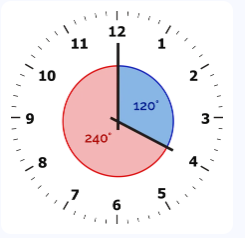1. What is a Clock Angle Calculator?
Definition: This calculator computes the angles between the hour and minute hands of a clock at a given time, specifically the angle from the hour hand to the minute hand (clockwise) and from the minute hand to the hour hand (clockwise).
Purpose: It is useful in geometry education, time-related calculations, and applications like clock design or animation, helping users understand angular relationships on a clock face.
2. How Does the Calculator Work?
The calculator uses the following formulas:
- Hour Hand Angle \( \theta_h \) (degrees): \( \theta_h = (h + \frac{m}{60}) \times 30 \), where \( h \) is hours, \( m \) is minutes.
- Minute Hand Angle \( \theta_m \) (degrees): \( \theta_m = m \times 6 \).
- Absolute Angle Difference: \( |\theta_h - \theta_m| \).
- Smaller Angle: \( \min(|\theta_h - \theta_m|, 360 - |\theta_h - \theta_m|) \).
- Angle from Hour to Minute Hand \( \theta_{hm} \): If \( \theta_m \geq \theta_h \), then \( \min(\theta_m - \theta_h, 360 - (\theta_m - \theta_h)) \); else \( \min(\theta_h - \theta_m, 360 - (\theta_h - \theta_m)) \).
- Angle from Minute to Hour Hand \( \theta_{mh} \): \( \theta_{mh} = 360 - \theta_{hm} \).
- Radians Conversion: \( \text{radians} = \text{degrees} \times \frac{\pi}{180} \).
Steps:
- Input the hours \( h \) (0–12) and minutes \( m \) (0–60).
- Validate inputs (hours: 0–12, minutes: 0–60).
- Calculate the hour and minute hand angles in degrees.
- Determine the smaller angles in both directions (hour to minute and minute to hour).
- Convert angles to radians if selected by the user.
- Format outputs to 4 decimal places or scientific notation for small values.
3. Importance of Clock Angle Calculations
Calculating clock angles is important for:
- Geometry Education: Teaching angular measurements and their applications.
- Clock Design: Ensuring accurate positioning of clock hands in analog designs.
- Animation and Graphics: Creating realistic clock visualizations in software or games.
4. Using the Calculator
Examples:
- Example 1: Time: 3:00 (Hours = 3, Minutes = 0)
- Hour Angle: \( \theta_h = (3 + \frac{0}{60}) \times 30 = 90 \, \text{deg} \)
- Minute Angle: \( \theta_m = 0 \times 6 = 0 \, \text{deg} \)
- Hour to Minute: \( \theta_{hm} = \min(90 - 0, 360 - (90 - 0)) = 90 \, \text{deg} = 1.5708 \, \text{rad} \)
- Minute to Hour: \( \theta_{mh} = 360 - 90 = 270 \, \text{deg} = 4.7124 \, \text{rad} \)
- Example 2: Time: 2:30 (Hours = 2, Minutes = 30)
- Hour Angle: \( \theta_h = (2 + \frac{30}{60}) \times 30 = 2.5 \times 30 = 75 \, \text{deg} \)
- Minute Angle: \( \theta_m = 30 \times 6 = 180 \, \text{deg} \)
- Hour to Minute: \( \theta_{hm} = \min(180 - 75, 360 - (180 - 75)) = 105 \, \text{deg} = 1.8326 \, \text{rad} \)
- Minute to Hour: \( \theta_{mh} = 360 - 105 = 255 \, \text{deg} = 4.4506 \, \text{rad} \)
5. Frequently Asked Questions (FAQ)
Q: What is the angle between clock hands?
A: It’s the smaller angle formed by the hour and minute hands, measured clockwise in either direction (hour to minute or minute to hour).
Q: Why are there two angles calculated?
A: The calculator provides both directions (hour to minute and minute to hour) to show the full angular relationship, as the smaller angle depends on the direction of measurement.
 Home
Home
 Back
Back
